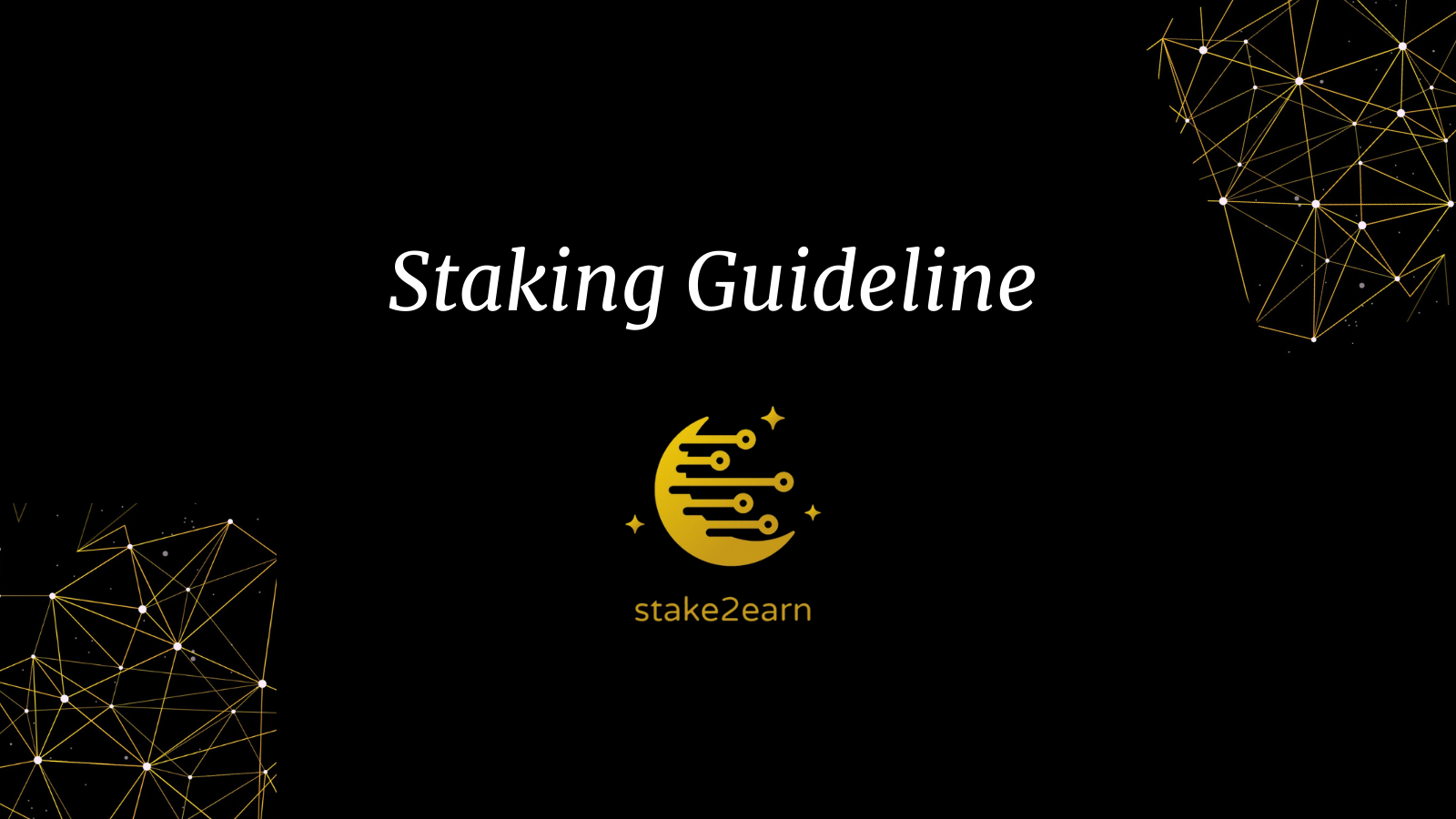
Over the past few years, blockchain and cryptocurrencies gain an important place in the economy of an individual. It shown people an alternative way of earning money and increase your passive income.
Nowadays, there are millions of people around the globe that are mining coins, trading, arbitrage or even staking coins in order to gain money. And, they do earn lots of money!
However, there is a myth that you can gain money only if you have Bitcoin or Ethereum, only if you search crypto market for low prices, buy the coins when they reach the bottom and sell them when the price goes up. However, trading is not the only way to earn passive income. What many people don’t know is that staking is one of the most stable methods to earn more coins without doing anything.
Here is a short guideline about staking, everything a newbie should know in order to understand the basics of this process:
1. What is staking
The simplest definition of staking is that this is the process of earning rewards by just holding certain cryptocurrencies.
The concept behind is similar with making a deposit in a bank and for keeping your money there you receive a certain % per year. In the crypto world the % is called APR and it may change depending on the number of delegations. For example, if the number of delegated tokens/coins increases, the APR will decrease.
This is why, staking is a long-term process rather than an income won immediately.
However, you can stop whenever you think this is not worth it anymore. This is called unstaking process. It may be that you consider changing your validator/staking company, this process is called restaking. Regardless the reason, unstaking and restaking are available for the user.
2. Proof of stake (POS)
Proof of stake or simply called POS, is a ‘greener’, ‘environmentally friendly’ way of verifying and validating a transaction or a block.
The concept behind it is that a person can validate a transaction/block according to the number of coins they hold. This way, instead of using lots of energy to solve puzzles, just like in POW system, here the POS user is limited to validating only a certain % of transactions equivalent with his ownership stake.
For example, if a person owns 5% of the coins/tokens available, he will be able to validate only 5% of the blocks.
Did you know?
The first coin that adopted POS method was Peercoin. Peercoin was launched in 2012 and it’s based on Bitcoin framework, however it became the first altcoin that targeted Bitcoin’s high energy consumption problem.
Even though, the largest cryptocurrency in the world (Bitcoin) is not using PoS, this is still a less risky system then the one used on BTC. Why is that? Simple! The way the system is created, it makes the compensation for the attack less advantageous for the miner to attack it. Funny, right?
3. Proof of work (POW)
Proof of Work or simply called POW, it’s basically the system used by Bitcoin and Ethereum, each one of them using it in their own way.
Proof of Work is also the original consensus algorithm in a blockchain network. This algorithm is used to confirm transactions and to create new blocks to the chain. In this algorithm, we have miners that compete against each other in order to gain the role of completing the transaction on the network. This process requires a huge amount of effort, which is translated by a lot of energy consumed.
Most of you might have already heard of miners that do it to earn more Bitcoin. The system/technology is similar with POS but one of the biggest differences is that it requires huge amounts of energy, energy that comes only from other miners joining the network.
Did you know?
At first, POW was developed as a solution to the growing problem of spam emails.
In 2021, each Bitcoin transaction consumes 1,173 kilowatt hours of electricity. That's the volume of energy that could "power the typical American home for six weeks," the author added.
4. Nodes
The simplest definition of a node is that it is a computer out of many other computers, running in a certain network and that follows the rules and shares information.
Long story, the blockchain system is formed of numerous blocks of data that are stored on nodes. Nodes that can be compared with small servers. All the nodes are connected to each other and they continuously communicate one to another, making sure that all nodes remain updated.
On a POS blockchain, the nodes are actual servers. On a POW blockchain, the nodes are any computer that is constantly running Bitcoin Core or other POW core networks.
There are several types of nodes:
* Light Nodes
Light nodes are also named Lighweight Nodes and these are used only for downloading blockheaders, in order to save the user important amount of download time and storage space. Light nodes do not store full copies of the blockchain.
* Archival Full Nodes
Archival Full Nodes or more known as Full Nodes, are the primary node type that hosts the entire blockchain and saves every transaction in their database. The main role of these nodes is to validate blocks and maintain the consensus up and running.
* Pruned Full Nodes
The Pruned Full Nodes are maintaining a good hard disk space for its users. Their main role is to delete older blocks in the blockchain, in order for the node to only host recent transactions up to a set size limit.
* Mining Nodes
These nodes can be either Light Nodes or Full Nodes. To accomplish the mining purpose, the miners can be either Archival Full nodes themselves or receive the data from other nodes to learn the status of the blockchain and learn how to find the next block.
* Authority Nodes
Authority Nodes are only used by consensus algorithms for networks that are not fully decentralized, but they work the same as Full Nodes in other networks. The number of Authority Nodes and who is to run them, it is decided by those networks or voted by the community.
* Lighting Nodes
These are nodes that connect the users outside the blockchain offering the so called “off-chain transactions” service. This helps reducing the load on the network, and it may be faster and cheaper option to perform the transaction.
* Masternodes
Masternodes are used to validate and record transactions in the database, and its main purpose is for the users to earn a share of the network’s rewards. In order to create a Masternode, it is required to first lock a certain number of coins/tokens decide by each network.
If you were wondering if you can earn something from running a node, there are some advantages:
- You learn more technical skills. In order to run nodes, you need to have a technical background, so this is a good opportunity to gain more knowledge
- Be part of securing the network and maintaining the blockchain
- Charge a small fee for each transaction that is validated through your node - validator
5. Validators
A validator is a special kind of node that participates in the consensus, and becomes responsible for verifying, voting and maintaining a record of transactions.
Validators store a copy of the blockchain of the network and must perform certain functions in order to keep the system secure. Depending on the network, there might be a limited number of Validator nodes or unlimited. For example, for Solana there is not a limit number of validator nodes, however Cosmos has only 150 spots.
The most essential part of POS system (Proof of Stake) is represented by validators. They are acting like moderators of the staking system and they have the important job of adding new blocks on the chain.
In order to have the most decentralized system as possible, it is important to elect a good number of validators. This helps the community by offering a greater variety of staking options as well as protecting the system by preventing having the blockchain controlled by one very wealthy validator.
6. Centralized staking
Centralized staking is more similar with the concept of lending, as the user gives up direct access to his coins/tokens, in order to earn higher rate of return or APR.
Centralized staking providers do not operate on POS entirely, they can offer staking services on networks that are not built on Proof of stake consensus mechanism, such as Bitcoin.
In most of the cases, centralized staking providers are also crypto exchange, such as Binance or Coinbase. Users simply create an account, deposit or transfer their coins/tokens and the provider will handle the rest.
7. Decentralized staking
Decentralized staking is offering non-custodial services, by not holding user private keys and withdrawal keys.
Basically, the user locks his coins/tokens in a cryptocurrency wallet to participate in maintaining POS system and earning rewards for this.
When the staking process is performed, the coins are being hold on networks blockchain and not staking provider’s account, as per centralized staking services.
8. Centralized versus Decentralized staking
There are advantages and disadvantages as per every other service in the world.
Centralized staking comes handier for beginners. It’s great for a beginner that just bought a certain coin and wants to start staking it immediately regardless of the technology behind that coins’ network. For example, the user bought Bitcoin and wants to stake, it’s a network on POW and not POS, so won’t be found on decentralized validators.
Also, centralized staking does not require using more platforms. The user creates an account, passes KYC (documentation process similar with the one for banks) and has everything available inside one single application.
Decentralized staking offers you the possibility to be at all time the owner of your coins/tokens. You are not required to create an account; you don’t have to pass KYC. You are in complete control of your private keys. It does not require complicating infrastructure as most of the tools/ applications used now for decentralized staking are very user friendly.
The most important aspect of decentralized staking, using this kind of services you promote the network and industry decentralization.
9. How to choose a validator
Every user is free to choose their validator depending on their own personal and subjective criteria; however, we recommend you to do your research well before choosing a staking company. Always check if that company appears on your coin website as professional validator or even on dedicated websites that promote validators.
Try to talk with their customer support in order to get all your answers to all your questions. This is an important step and you need to be sure and have trust.
Below you may find the 5 key rules:
- Amount of self-delegated tokens — This means the number of tokens a delegator self-delegated to himself. The greater the amount, higher the liability he shows.
- Number of delegated tokens — This means the number of tokens a delegator received from his delegators. A higher amount shows that the community trusts that validator in particularly. However, we need to look at the history of that validator too. We might encounter centralized validators with high amounts, but Blockchain is all about decentralization. So, we shall encourage the small validators too.
- Commission rate — This is the commission a validator applies to his delegators. Usually, one chooses the validator that has the smallest commission rate percentage. Thus, we should also think about the infrastructure behind a project like this and understand that not all validators can sustain the costs from their own pockets and it’s normal to have a commission.
- Take a look at the tech competitiveness of a validator — It’s very important to choose a validator that has technical background and can prove a consistent technical setup, stability, and constant monitoring. Also, keeping infrastructure updated is very important.
- Choose a validator with a high social reputation — Active validators should be involved in community discussions, support users in chats, create support materials for the community, etc.
10. Benefits and risk of staking
Staking has grown in popularity among crypto holders in the past couple of years, as it allows them to earn additional income.
Some of the benefits of staking are:
* Passive income generated
* User friendly approach – staking is really easy and does not require technical knowledge, which becomes accessible to every crypto holder.
However, everyone keeps asking if crypto is safe, if someone can steal your coins, what if the validator is a scammer and so on.
Here are some of the risks of staking:
* Blocked funds indefinitely – If you choose staking with a centralized staking provider, you might encounter the situation when your account is being suspended due to one of the articles in Terms and conditions.
* Value of the coin falls and the coins are still blocked – If you choose staking with a Centralized staking provider you might have the coins/tokens blocked for the period you chose to stake (1 month, 2 months, 6 months). If you choose to stake with a Decentralized staking Provider, you have the option to stake for as long as you want but you can unstake whenever you want. The coins/tokens will become available depending on the rules of each network. For example, for Solana is one epoch (2.5 days), for The Graph is 28 days, for Cosmos is 21 days etc.
* Validator node you chose to stake with may be penalized for being inactive. For example, if the validator does not maintain the up time of the server, does not keep the network updated to latest versions, the validator can go to slashing. Slashing is a process implemented only on some of the projects but it means that the validator and the delegators will be penalized a certain %. If you just staked with such validator and slashing starts in a few hours or even 1-2 days, instead of earning rewards, you lose % from the number of coins/tokens staked.
Overall, is clear that POW becomes old grandpa in comparison to POS, and staking is the new trend. The shift towards staking will get stronger and stronger in time, so don’t lose time. Remember the saying ‘Time means money’, this applies to crypto too.
If you already hold certain coins/tokens: Ready – set- stake! Now is the time!
Happy staking everyone! 😊






